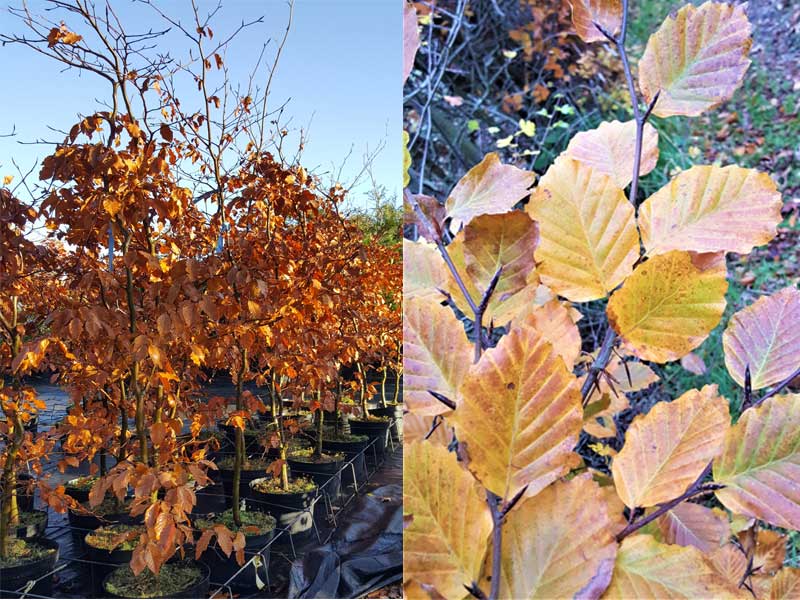Fagus sylvatica – Green Beech
Fagus sylvatica – Green Beech – Pot Grown
| Botanical Name | Common Name | Sizes Supplied | Item Price (£) + VAT | Pot |
|---|---|---|---|---|
| Fagus sylvatica | Green Beech | 120-150cm | 8.50 | 10ltr |
Fagus sylvatica – Green Beech – Bare Root & Root Ball
| Botanical Name | Common Name | Sizes Supplied | Item Price (£) + VAT | Type |
|---|---|---|---|---|
| Fagus sylvatica | Green Beech | 100-125cm | POA | BR |
| Fagus sylvatica | Green Beech | 150-180cm | POA | BR |
Key: BR = Bare Root | (Available November to March – Min Order 50 no. )
Details / Key Facts
Fagus sylvatica – Green Beech is a native plant which creates a great garden hedge varying in appearance throughout the seasons. Soft green leaves emerge in springtime which fill out into the summertime, turning yellow to orange in Autumn. It then retains its copper brown leaves for most of the winter. It is slow growing and particularly likes sandy and dry soils and won’t tolerate heavy or wet soil. It is hardy and likes both sun and shade.
Key Facts
- Common name: Common beech
- Botanical name: Fagus sylvatica
- Group: Hedge
- Planting time: October to late winter when dormant
- Height and spread: Recommend 5 plants per metre in a double staggered row
- Aspect: North-facing or East-facing or South-facing or West-facing. Full Sun or Partial Shade
- Hardiness: Hardy
- Difficulty: Easy
- Soil: Sand, Chalk, Loam (Ideal for Sandy Light free draining Soil Types)
PLEASE NOTE:
Native Mixed hedging is traditionally made up of 50% hawthorn & blackthorn, with remaining 50% split between the other varieties.
Minimum order 50 plants of each variety.
Recommend 5 plants per metre in a double staggered row.
How To Grow
Beech is tolerant of a wide range of soil conditions, including well-drained chalk. On soils prone to drought, winter waterlogging or on heavy clay, however, hornbeam is a better choice though the leaves are more textured than beech and it tends not to retain as many dried, dead leaves in winter.
Position in full sun or partial shade; purple-leaved cultivars keep their leaf colour better in full sun; yellow-leaved cultivars retain their colour better in partial shade.
Beech hedges are not suitable for very cold areas, or for sites in frost pockets (often found in low-lying sites), where the new tender growth of beech can be severely damaged by late spring frosts. Again hornbeam would be better suited.
Water freely from spring to autumn to ensure that the hedge doesn’t dry out, especially in the first three years after planting. Regular mulching will also help retain water around the roots of the hedge on drier soils.
As hedges are regularly clipped apply a general fertiliser such as Growmore or blood fish and bone at 50-70g per sq m (2-2½ oz per sq yd).
Planting beech hedges
Langley Horticulture recommend 5 plants per metre in a double staggered row. Hedges are in place for many years so thorough preparation of the soil before planting is essential. See the advice in the profile on hedge planting for more information.
Bare-root transplants are not only cheaper but also usually establish better. Plant during mild weather from October to late winter and space at 45-60cm (18in-2ft).
Nesting birds
When undertaking work on garden hedges check that there are no birds nesting, as it is an offence under the Wildlife & Countryside Act 1981 to damage or destroy the nest of any wild bird while it is in use or being built. The bird nesting season is usually considered to run from 1st March to 31st July (though it may last longer for certain species or multiple broods so always check if in doubt).
Pruning & Training
Initial pruning and training
If the transplants are well branched avoid cutting them back. Otherwise, for the first two years after planting, concentrate on shortening the longer shoots and just tipping back shorter ones to encourage branching and dense growth without much loss in height. Trim in the second week of August.
From the third year onwards, trim the sides of the hedge, aiming for a flat-topped A-shape (in cross section) to ensure that sunlight reaches the top and bottom equally. Aim for a width of about 1m (3¼ft) at the base, tapering upwards to the desired height.
Pruning established hedges
Once established trim regularly in August. This late summer trimming allows the hedge to retain its recent flush of new leaves over the winter in a brown, autumnal state, providing year-round screening. If you are too late for August pruning wait until spring.
To renovate an overgrown beech hedge, cut it back hard in February while still dormant but delay if the weather is very cold. If the height needs reducing by 50 percent or more, then stagger pruning over two seasons rather than doing it all at once. If the sides need drastic reduction, then do one side and the top in the first year, leaving the other side to the second year. However, where recovery is poor, with little new growth, delay completion of cutting back for a further twelve months.
To obtain accurate levels and angles when renovating, use garden lines stretched tautly between sturdy canes or stakes driven in at the ends and at intervals along the hedge. Cut so that the sides slope slightly inwards; the hedge narrowing a little from base to apex. This encourages lower growth. Use a pruning saw for cutting thicker growths. It is not necessary to apply any wound treatment to pruning cuts. Mulch and feed after renovation, to encourage regrowth. A general purpose fertiliser such as Growmore is ideal, applied along both sides of the hedge where possible. Water thoroughly from time to time during any dry periods in the first growing season following cutting back.
Delivery charges may apply and will be based on the order size and location so, please provide us with as much information when you contact us with your enquiry.
If you would prefer to collect up your order please email sales@langleyhorticulture.co.uk to make an appointment.
Please note that payments cannot be made online. A member of staff will call you and take payment over the phone.

